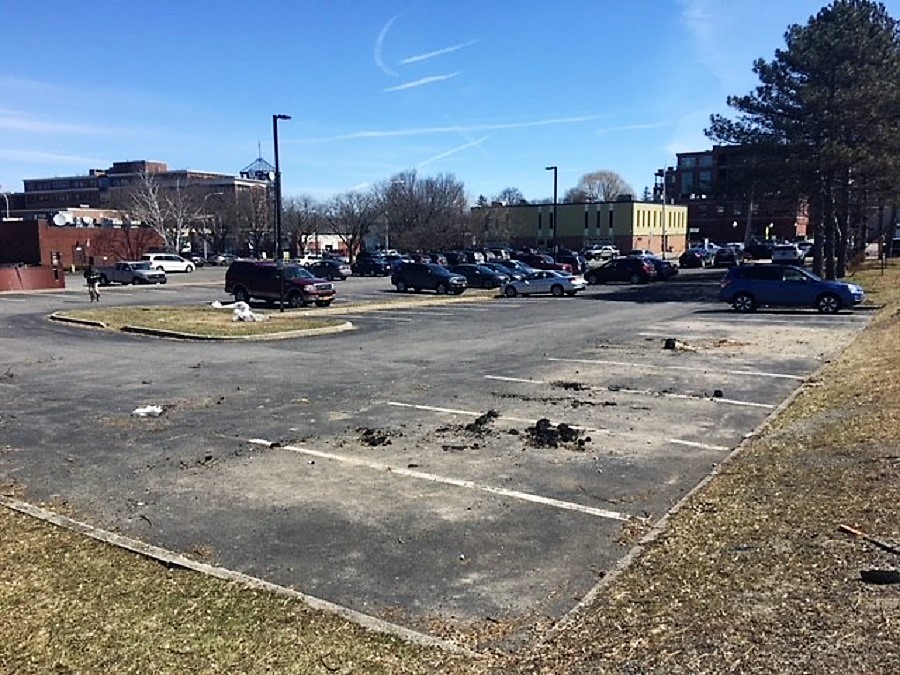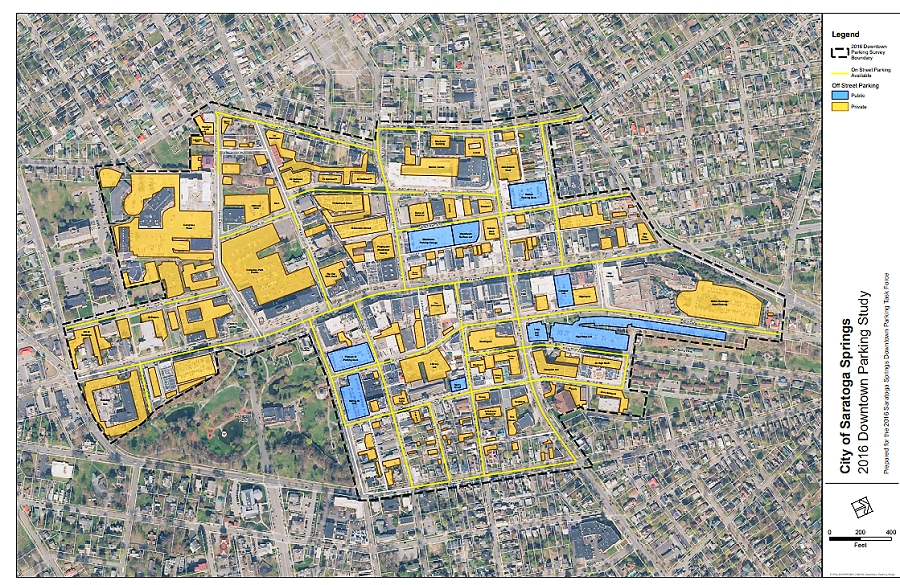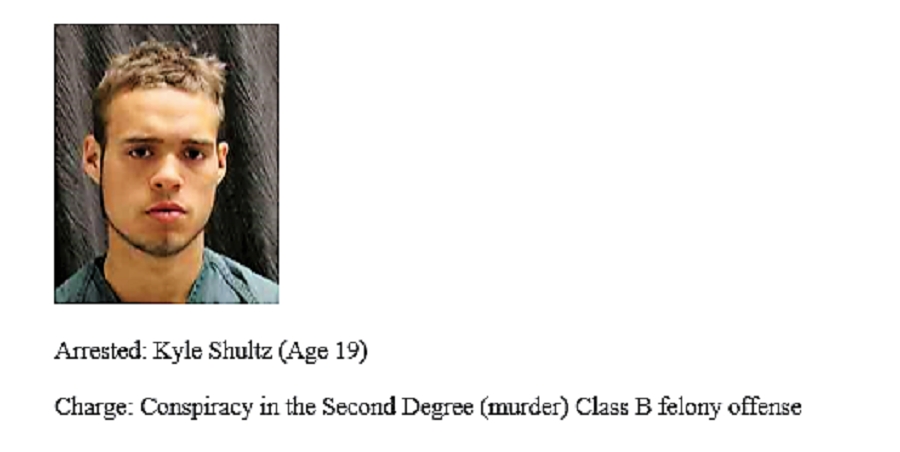Changing Times, Changing Tactics
They crept down the hallway, two abreast, draped in their flak jackets and helmets and with weapons drawn.
A dispatcher’s voice crackled over the radio: “loading dock, amphitheater, for an individual armed with a handgun.”
City Police, State Police, State Park Police and members of the Saratoga County Sheriff’s Department gathered this week at the Saratoga Performing Arts Center to practice responding to terror scenarios involving an active shooter.
“It’s reality based and we try to do this as realistically as possible,” said State Park Police Lt. Donald Benware, as the officers took turns walking through the theater’s backstage area, confronting a “shooter,” and exchanging a volley of simulated rounds.
“We try to put the officers at a higher stress level (in the training). Let’s face it, we’re all human beings. Your blood pressure is going to go up. Get the adrenaline level up so they can feel that adrenaline rush and make sound decisions,” Benware said. “Also, it’s very important be able to come down off that. After an incident happens, they may be moved to another location and they need to be able to bring that heart rate down, bring their decision-making skills back into a more focused ability.”
One benefit of involving multiple agencies in the scenarios is that it builds a familiarity between law enforcement officials who don’t normally work alongside with one another. “Doing this type of training, we all get to see different faces and know different people and how they react in situations, so you have a little bit of a confidence, a little bit of an edge in a worse-case scenario if you have to respond to something like this,” Benware said.
Over the past 50 years, incidents have prompted law enforcement agencies to re-think their roles in response. In the 1960s, police departments began building special teams in reaction to terror-based incidents. The city of Los Angeles led the way with their Special Weapons and Tactics unit, or SWAT. But, the police response to active shooter incidents began to change following the Columbine High School massacre of 1999. Police showed up almost immediately after the shooting began, but waited for SWAT officers, who didn’t enter the school until much later. Police departments today focus more on stopping the shooter as quickly as possible, rather than waiting for SWAT teams to arrive, according to the 2014 report “Critical Issues In Policing Series,” published by Police Executive Research Forum.
Since that time, names like Columbine and Sandy Hook, Parkland and Virginia Tech became part of the sad map in American consciousness.
Last month, Saratoga County Sheriff Michael Zurlo announced he has a team of four deputies assigned to schools throughout the county who patrol during the day shift as well as the afternoon shift, and periodically conduct a school walk-thru to interact with students and school staff. While notable incidents have occurred in schools, some of the deadliest single day mass shootings in U.S. history have recently occurred where large gatherings of people come together: 49 people were killed and more than 50 injured inside an Orlando nightclub in 2016, and last October 58 people were killed and nearly 500 injured when a 64-year-old man opened fire on a crowd of 22,000 concertgoers in Las Vegas.
“We pull scenarios right out of the headlines,” explained Saratoga Springs Police Department Lt. Shane Crooks. “We look at different incidents that happen around the country and the world and we take those and fit them into a situation with the area that we have here. Any place you have a large gathering increases your risk of an attack. And this multi-force reality-based training here - we’re training where an incident could occur,” he said.
“The four agencies represented here today are the ones who will be here if something happens. By doing this type of training, we are preparing. We’ll have a better response, we’ll handle the situation better and keep everything safer,” Crooks said. “Every officer here is also learning the layout of SPAC, the grounds and the amphitheater itself, so if they do have to respond to a call, they’ll have that knowledge ahead of time.”
“This is in our jurisdiction. This is our home and our responsibility. That’s why we’re choosing this venue,” Benware added.
“We did have an incident back in the ‘70s in Saratoga Springs, at St. Peter’s. So, it can happen,” said Crooks, noting a December 1975 incident when a 32-year-old man recently discharged from the U.S. Navy aimed his .22-cal. handgun out his second-floor apartment window and fired four shots into St. Peter’s Elementary School playground. Two 7-year-old girls were injured.
“Every time something happens we re-evaluate our training, we change our tactics to prepare our officers to better respond to an incident,” Crooks said. “We want to respond as quickly as possible and we train the officers that we need to have a fast response to eliminate the threat.”
Rip Van Dam Hotel Revisions; Planning Board to Consider Code Blue Shelter Next Week
SARATOGA SPRINGS – Representatives of the Rip Van Dam hotel project provided a revised update of their plans to the Planning Board on April 5.
Among the revisions: the previously suggested orange brick face of the building has been changed to feature a softer white appearance; the proposed banquet facility will be replaced by a restaurant, and the newest configuration will total 159 rooms. Previous proposals varied between 142 and 176 rooms.
Parking will be via a multi-story garage with a 341-vehicle capacity to be built on Hamilton Street, just south of Congress Street, atop a current flat lot.
The Planning Board is slated to consider Shelters of Saratoga’s application(s) for a special use permit and site plan review for a proposed permanent Code Blue emergency homeless shelter on Walworth Street. It is anticipated the board may consider those applications at its next meeting, on Thursday, April 19.
This is the current lot, facing Hamilton Street, where a proposed multi-story garage will be constructed.

Upcoming Meetings
Monday, April 16: 9:30 a.m. City Council Pre-agenda Meeting.
Monday, April 16: 5 p.m. Planning Board Workshop.
Tuesday, April 17: 7 p.m. City Council Meeting
Wednesday, April 18: 7 p.m. Design Review Commission Meeting
Thursday, April 19: 6 p.m. Planning Board Meeting.
Local Restaurant Servers: Cuomo Wage Hike a Bad Tip
SARATOGA SPRINGS – A Gov. Cuomo directive to explore raising the wages of tipped food service workers to a flat rate is drawing the ire of many of the local workers for whom the idea was supposedly initiated to benefit.
“What the motives are I don’t know, but it’s apparently been presented to Cuomo like he’d be doing us a favor,” says Amanda Broderick, who has worked in the local restaurant industry for 16 years, the past nine at Olde Bryan Inn. “The servers aren’t asking for this (and) it would just devastate the local economy. They’re not doing us a favor.”
In upstate New York, the general hourly minimum wage is $10.40 per hour. Tipped food service employees make $7.50 per hour, before tips. When tips are added, many workers say they are capable of earning much more than the state minimum wage, based on the level of service they provide to customers. Besides wait staff earning more, this also enables restaurants working on slim profit margins to save the $2.90 difference per employee, per hour, as a “tip credit.”
The proposal to raise tipped food service workers to the general hourly minimum wage would eliminate that tip credit - forcing restaurants to pay more while assuming workers will earn less, and set into motion a decline in the labor force as well as restaurant service, and higher prices for dining consumers, the workers say.
“The best part of this industry is the relationships you build,” Broderick says. “And I do try to build those relationships because you get rewarded for the service you provide. I know the harder I work, the more money I can make.”
Broderick and her husband recently bought a house on the Great Sacandaga Lake. The daily commute to Saratoga Springs takes 45 minutes to one hour, but it is a trip that is worth it, she says, because the hours are flexible, the staff is passionate, and the money Broderick is able to earn helps pay the mortgage. One of the workers’ concerns is that if their basic wage is raised to the state minimum, tips would cease to exist.
“Right now, a lot of us make way more than the minimum wage. The tip credit helps restaurants pay a lower wage and keep prices down. What would happen is we’d end up making a lot less, menu prices would go up and eventually the mom and pops that Saratoga has so many of would have to close,” Broderick says. “If (Gov. Cuomo) is trying to find extra tax revenue, think of all the taxable income that would be lost in places like Saratoga. You don’t want to mess with a good thing.”
The Employee Policies Institute, a non-profit research organization that studies public policy issues surrounding employment growth, cites Census Bureau data that indicates tipped restaurant servers self-report earnings of more than $17 per hour on average statewide in New York, and suggests those estimates “are likely conservative.”
Susan Mezera has worked as a server for the past 43 years, from the former Lillian’s Restaurant to her current position at the Olde Bryan Inn. Working in the industry has helped her put her two children through college.
“When the public hears servers get minimum wage, people will have the perception that it won’t be necessary to tip,” Mezera explains. “People have mortgages and car payments. They’ve established their lives on the income they make, and that will drastically change. It’s already been practiced in other places and it didn’t work. Maine instituted this and a year later repealed it because it was such a disaster.”
In November 2016 a referendum to raise both the regular and tipped minimum wages in Maine won with 55 percent of the vote. Soon after, tipped servers began to complain that their earnings were being hurt as a result of customers tipping less. The measure was overturned in June 2017 in 110-37 vote by lawmakers.
Increased Costs for Restaurants
“For the restaurants, it would mean a large increase in labor costs. You’re looking at 30 servers and bus people in just one restaurant who are tipped employees - and restaurants are working on a small margin as it is. They may have to raise menu prices and put service charges on top of the bills to cover that. Servers would be let go and they’d probably do away with bussers and hostesses. The work would be spread real thin,” Mezera says. “With more tables to take care of, the quality of service will go downhill. If this happens and then at some later point they decide, ‘oh, this is not working,’ how many restaurants will have gone out of business? This is a busy town with the City Center, with it being a college town and there are a lot of restaurants. If half of them are gone, how many people will be laid off and out of work?”
A locally initiated online petition at change.org titled “Supporters of the Tip Credit in New York” has secured more than 7,000 signatures, and a collective group of business owners and employees urging Gov. Cuomo to preserve the Tip Credit have formed the Save Ny Tips Coalition, which hosts a web site and numerous social media pages with the hashtag: #savenytips.
“I think the group that’s really pushing it is a minority of people working in the restaurant industry who are Cuomo’s voter demographic in New York City. I think it’s purely political,” says Giuseppe Chiaravalle, who works at Wheatfields Restaurant.
“Look at it this way: when you go to a restaurant, you want to be wined and dined, you want good service. Going to a restaurant is an experience: the food, the ambience, the service. Servers know through their hard work, they can provide a superior experience to a customer and that they can get compensated for it with a tip,” Chiaravalle says. “I am willing to take less pay from the business knowing that through my hard work, I can actually make more and lift myself. I know I can work as hard as possible and see the results. Why would you take that incentive away?”
Workers say while they would earn a few dollars more in the raising of the minimum wage, the public would tip less, if at all. And without the incentive to earn tips, many would seek other opportunities in less challenging fields.
“On a track Saturday, where you’ve got five, six different tables and you’re running around the restaurant with 10 things in your head, why would you do all that if you’re only getting paid minimum wage, when you can make the same amount standing at a cash register,” Chiaravalle says. “The hardest working people will look to find a job that’s easier for the same pay. Service will go down because the best of the best are leaving and prices will go up. It’s not a situation where anyone wins.”
Higher Menu Prices
“It definitely would not be good for tourist places like this,” says Saratoga native Brayden Bosch, who has worked in the industry 11 years. “People come here for the track, but they also come for the nightlife-dinner side of it, and it wouldn’t be what they’re looking for anymore. The owners would have to pay a lot more, the workers who remained would be less enthusiastic and on top of that your food would cost more. So, people might not have to tip - but your $20 meal might cost $30 now. Before you could pay $25 with tip and everybody is happy.”
On the restaurant business side of things, the elimination of the tip credit would cost owners more money to meet the minimum wage gap, and those costs will continue to rise. The general hourly minimum wage in upstate New York is scheduled to increase to $11.10 at the end of this calendar year, up to $11.80 in December 2019, and to $12.50 one year after that.
“It would be disastrous,” says Nicci Miller, general manager at Wheatfields Restaurant, who began working in the industry 25 years ago as a busser at Lillian’s.
“You would have a whole group of working people who would lose everything. You have the restaurant owners who could potentially lose their business. Then you have the consumers who will lose every level of service they’re used to. All across the board, it’s a very bad idea,” Miller says.
“From a management perspective, raising wages by that much would be disastrous. In reality, it would stop being the hospitable town we are – which is part of Saratoga’s charm, that face-to-face interaction with people. There’s that communication as a server: where to stay, what to do, what to eat. You’re the visitor’s booth and you’ll lose all of that. It would change service in the entire state of New York,” she says.
And it’s not just the waiter or waitress you visibly see at the restaurant who would be affected, Miller explains. There is an entire support staff who depend on tips.
“You tip out the server 20 percent. From that, he tips 3 percent of that to the bar, because they’re making his cocktails, 2-1/2 percent to the busser who fills his water and clears his dishes, and another 1-1/2 to 2 percent to your food runner, who’s the person who brings the food to the table. It’s such a big circle, everybody takes a piece of it. And they all earn that money, they really do,” she says. “There’s a perception you have a restaurant owner that makes all this money, but in this business, you’re literally making pennies on the dollar.”
Gov. Cuomo previously raised the tipped workers’ minimum wage from $5 per hour to $7.50 in 2016. “We just took a 50 percent increase, and at $7.50 it’s one of the highest in the country,” says Tim Holmes, who with his wife Colleen owns and operates three restaurants in Saratoga Springs and four restaurants overall in Saratoga County.
“I ran the numbers on my company and if he was to pass this to go in effect in 2019 it’ll cost our company about $300,000. And that’s only the first jump before it goes up again,” Holmes says. With a slim profit margin, that amount would have to be made up potentially by reducing jobs and increasing prices. “But I’m not sure that we even can make all of that up,” Holmes says. “It’s a devastating number.”
Gov. Cuomo directed the Commissioner of Labor in December to schedule public hearings to examine industries and evaluate the possibility of ending minimum wage tip credits in New York State. The Department of Labor will be conducting those public hearings on Long Island on April 20, in Watertown April 25, Syracuse on April 30, Buffalo on May 7, and at the Legislative Office Building in Albany on May 18.
“Through the years you learn that your quality of service - how you take care of your customers – directly relates to the amount of money you can make,” Mezera says. “People go out to dinner for the experience: to be waited on, to interact with the server. You build up relationships through the years. They come in and ask for you. You’re able to share their special family moments, because you’ve established that amount of care with your customers. If they just wanted food they could go to a drive-through, or the places that have iPads on the table – which is what could happen if this goes through,” she says. “People are coming out and it’s our job to make them feel better, to have them enjoy their meal and to go out with a smile on their face.”
Correction: an earlier printed edition and online posting of this story contained a misspelled name of an interviewee. It has been corrected in this online edition.
“A Place All Saratogians Can Experience” - Grand City Venue Sets Sights on 2019
SARATOGA SPRINGS – A scatter of workers amble through the vintage chambers of Universal Preservation Hall, exploring the possibilities. Design plans sprawl across tabletops beneath stained-glass windows and free-standing easels boast colorful images of what will be. Soon, the heavy lifting will begin.
When the $8.7 million restoration of UPH is complete, in late 2019, the 19th century building will provide Saratoga Springs with something it has sorely been missing: a mid-range capacity venue with state-of-the-art sound, open year-round and expected to stage more than 200 events.
“It’s going to be a huge performance venue,” says Teddy Foster, whose association with UPH goes back more than a decade - from board member to president to its current campaign director.
“We’re going to be a huge music room, that’s how it’s being designed. We anticipate doing some Broadway cabaret and some live theater; we will be a place of collaboration for SPAC, for Caffe Lena, for people from the community, you name it,” Foster says, standing in the middle of a vacant 20-foot by 24-foot space on the main floor where the staging area for the 700-seat theater-in-the round venue will be constructed.
Tiered seating will be installed at the far end of the main hall – where the current stage sits – and at the opposite end, the balcony will be extended and fitted with seats that descend to the main floor. It will be handicap accessible with an elevator that navigates between floors, and a glass atrium will serve as the new entry way, off Washington Street, in “a super cool alleyway inviting people to come in,” Foster explains.
Event booking will be handled by Proctors, with whom UPH struck an alliance in 2012, and whose event management has included staging everything from major Broadway shows and cutting-edge film festivals to snagging pop music acts on national tours. Proctors’ stated mission: To be a catalyst - through arts and community leadership - for excellence in education, sustainable economic development and rich civic engagement to enhance the quality of life in the greater Capital Region.
Approximately 100 local jobs will be employed during the construction phase, which begins in earnest sometime between May and July. After the $8.7 million project is completed – expected to be in late 2019 - and the venue re-opens for business, it is anticipated UPH will bring approximately 65,000 visitors to the Spa City each year. “We will fill the hotel rooms and the restaurants during the off-the shoulder season,” Foster says. UPH also plans to hire six full-time employees and a number more on a part-time basis.
Earlier this week, Gov. Andrew Cuomo announced the venue will be awarded $750,000 to help redevelop the hall into a performing arts center. UPH represents Saratoga Springs’ sole recipient of the Restore New York Communities Initiative – which awards funding for projects that will reinvigorate downtowns and generate new economic opportunity in communities.
The Washington Street venue, which is a non-profit community performing arts center, is also entering into an energized public fundraising phase. The goal is to raise $5.5 million. “We’ve raised most of it,” Foster says. There is just under $1 million to go to reach that goal.
“I’m a huge music lover and I would love to see music of all kinds in that room,” says Foster. “You know this was built as a place where people could come together for all different kinds of things. That’s how we’ve kept it alive all these years. And that’s really what I want to have here: a place that all Saratogians can experience.“
City to Unveil Parking Management Bids Tuesday
SARATOGA SPRINGS - Bids received from the city’s request for proposals from potential parking management partners will be unsealed and publicly read 2 p.m. Tuesday at City Hall.
The city issued an RFP seeking the services of a professional parking consultant/management team to study, design and implement a Smart parking system in downtown Saratoga Springs. The stated goal, according to the proposal, is “to net the maximum financial benefit to the city balanced with downtown business vitality and efficient traffic management.”
Subsequent to selecting a winning bidder, the city is anticipated to host an organizational kick-off meeting on May 8.
The city currently owns and manages eight lots with approximately 1,288 “off-street” parking spaces, according to the Parking Task Force parking space inventory. There are an additional 1,302 public “on-street” parking spaces.
City owned and managed:
Public on-street parking: 1,302. Public off-street parking: 1,288 as follows:
- Woodlawn 3-level deck parking - 384
- Putnam St 2-level deck parking - 185
- Walton (Church St.) 2-level deck parking- 222
- High Rock upper & lower surface & Lake Ave. lot parking: 278
- Spring St surface lot parking - 98
- Henry St surface lot parking - 19
- Woodlawn surface lot parking – 60
- Collamer surface lot – 30
Additionally, non-city-owned and managed spots include: 83 spaces at the Saratoga Springs Public Library, and 2,552 spaces defined as “private off-street parking.”
Saratoga Inmate Charged with Conspiring to Murder Witness
BALLSTON SPA - A 19-year-old man incarcerated on a rape and robbery charge has been accused of conspiring from his Saratoga County Jail cell to murder a potential witness in the case against him.
According to police, 19-year-old Kyle Shultz, of Hudson Falls, was charged in May 2017 with first degree rape and second degree robbery, in connection with an incident that allegedly occurred in the town of Moreau. He has been incarcerated in County Jail since that time.
A statement released by the Saratoga County Sheriff’s Office reads as follows:
The Saratoga County Sheriff’s Office received information that an inmate in the Saratoga County Jail was communicating with another to commit a murder. An investigation was conducted which led to the arrest of Shultz on the charge of Conspiracy in the Second-Degree. Shultz is accused of taking steps to plan the murder of a person familiar to him who could be called as a witness in the case pending against him in Saratoga County Court.
The pending case stems from an arrest May 16, 2017 where Shultz was charged with Rape in the First Degree and Robbery in the Second Degree as the result of a Sheriff’s Office investigation into the rape and robbery of a female in the Town of Moreau that occurred earlier that day.
Shultz was arraigned by Judge Timothy Brown in Milton Town Court. Judge Brown remanded Shultz back to the county jail. No further arrests are expected in this case.
City Hits World Stage as Arts Destination
SARATOGA SPRINGS – Health, history, horses. And The Arts.
With the awarding of a $14,000 economic development grant this week, the city took the first step to promote Saratoga Springs as a worldwide destination for arts and culture. Finance Commissioner Michele Madigan calls it “having some skin in the game.” And that game has proven to bring in a notable return on the investment in other communities.
“Saratoga Springs is a fabulous brand. We’re over 100 years old and so is ‘health, history and horses.’ These are strong brands that you don’t want to get away from, but we need to add to it with arts and culture,” Madigan says.
The funds will support the Saratoga Performing Arts Center in the hiring of a public relations firm to promote the city as a thriving arts community to journalists and media beyond the Capital Region. The goal is to showcase all of Saratoga as a cultural hot-spot and entice visitors to journey to the region.
“Cultural tourism – the cultural tourist spends 60 percent more when they go someplace than the average leisure tourist does. Sixty percent more. We want culture to be an economic driver here the same way the track is, and there’s no reason why it can’t be that, and a lot more,” says Elizabeth Sobol, president and CEO of the Saratoga Performing Arts Center.
“I know there are many, many people out there looking for a place like Saratoga as their summer or winter destination who would just be up here all the time, if they just knew what was here,” Sobol says. “This is one of the most incredible places in the world for someone who cares about the arts and literature and green space. I go back to the perfect confluence of nature and art, man-made beauty and natural beauty, there’s nothing like this in all of North America. “
From Caffe Lena to SPAC, the Tang Museum, Yaddo, the future home of the Universal Preservation Hall and other amenities, the community has much to offer, Sobol says. “All this art just one beautiful trip up the Hudson River from Manhattan. That’s a big selling point to New Yorkers who want to get out of town.”
Commissioner Madigan says she sees the awarding of the funds as one piece of a larger plan. “When you think Saratoga Springs, what do most people think of? They think horses. And that’s great, but we also really want to attract the cultural tourist by putting the arts and culture focus on that same level as horses,” Madigan says. “Right now. I see this as first step. I have a bigger vision where we start getting stakeholders and key members of the community in a room to talk about who we are as a region, to start coming together as a whole as an arts and culture community and to market ourselves that way, to add to the health, history and horses brand. The Berkshires know who they are. Tanglewood is well marketed as a global venue. From a global, international tourist destination, we don’t really know who we are when it comes to arts and culture.”
Recently, the local arts took a hit with the announcement of the cancellation of the annual Hats Off and Final Stretch music festivals. And promoting the arts in Saratoga Springs is not always an easy thing.
Saratoga Springs resident Robert Millis first launched the American Music Festival in Lake George in September 2014. Facilitated through his 398 Group – which stresses the arts as a driver of economic development and community building – the idea was to bring thousands of people into the community and extend the tourist season. Lake George is located in Warren County and financial support for the festival was provided via monies collected in the North Country for the tax on the rental of rooms. It proved to be a success.
This summer, the festival – which has featured performers such as Blue Öyster Cult, New Riders of the Purple Sage and Sawyer Fredericks in the past – returns for its two-day stint, and based on the success of the music-as-economic development initiative, the village and town of Lake George have contributed $45,000 in grant funding via the “bed tax” to Millis’ group.
“Their philosophy is bed tax funds events, which in turn feeds the bed tax,” Millis says. The village of Lake George is providing funding for a couple of events. “It’s a big boost,” said village Mayor Robert Blais. “It’s helped us to extend the season.”
Like other Warren County municipalities, the village of Lake George and the town of Lake George each receive $30,000 annually to promote special events in their communities with the idea of bringing in people that will spend money in local businesses and stay at local hotels, says Blais, who also serves as chairman of joint village and town occupancy tax committee. And the return on the investment has been strong. After the events take place, receipts and taxes received are then distributed back to the communities in addition to the $30,000 flat fee to promote a new cycle of events. In the village of Lake George that return was about $185,000, Blais said; the town of Lake George received approximately $240,000.
Millis’ attempts to create a two-day music-based festival in his Saratoga hometown has proven to be more difficult. The proposed event and conference would be designed to help boost tourism and build a music ecosystem to enhance the local scene. “I’ve been floating that idea in Saratoga a for over a year, but nobody has jumped on board with me,” Millis says.
“Our (bed tax) money has already been sliced and diced and it happened long before I got here, but it’s an interesting concept,” Madigan says. “Our occupancy tax right now is split. We only get one percent. Two percent from occupancy tax goes to the City Center and two percent goes to convention and tourism. It goes directly to them. We get less than City Center and convention and tourism. The city gets $600,000, they’re getting $1.2 million each. So, I’m trying to get them on board with helping with the arts. Look, the city’s got some skin in the game so let’s get the chamber and convention and tourism also involved.
“To me, the arts is a huge part of economic development,” Madigan explained. “It’s untapped. This I think is economic development, under the guise of arts and culture. This is a first step. I look forward to coming forward with additional recommendations to support economic development and arts and culture as an aspect of that. “
Ringo at SPAC in September
Paris, France. Hamburg, Germany. Barcelona, Spain. Saratoga Springs, N.Y.
Ringo Starr and his All-Star Band embark on a four-month international tour in early June that will stage a show at Saratoga Performing Arts Center on Sept. 14.
The revamped All-Star Band includes Colin Hay - of Men at Work, Graham Gouldman – of 10cc, one-time Toto guitarist Steve Lukather, Santana/Journey keyboardist Gregg Rollie, drummer Gregg Bissonette and sax/flute/percussionist Warren Ham.
Saratoga Bust Nets: 20 Guns, Marijuana, 2.5 Kilos of Cocaine, more than $250K Cash Seized
BALLSTON SPA – Sheriff Michael Zurlo on Monday announced what he called “the largest seizure of illegal narcotics that I have ever seen in Saratoga County.”
The six-month investigation resulted in the execution of seven warrants on March 4 during which six people were arrested. Authorities seized 18 long guns, two pistols, 2.5 kilos of cocaine – with a street value of $250,000 according to Zurlo, 20 pounds of packaged marijuana – with a street value of $40,000, five vehicles and more than $264,000 cash.
In September 2017 the Sheriff’s office initiated an undercover investigation during which they infiltrated the suspected drug ring.
“The seizure has made a major dent in drug trafficking that occurs in Saratoga County,” Zurlo said Monday, thanking local, state, and federal authorities involved in the case.
Charged:
Dennis E. Jones, 64, Schuylerville. Charges: criminal possession of a controlled substance, and criminal possession of marijuana - both felonies, and two misdemeanor counts criminal possession of a weapon. Jones is suspected to be a large cocaine distributor operating for many years within Saratoga County, according to the Saratoga County Sheriff’s Department. Jones was allegedly found to be in possession of multiple firearms, 1.5 Kilos of cocaine and approximately 20 pounds of marijuana. He was sent to the Saratoga County Jail on no bail.
Kent D. Daniels, 54, Gansevoort. Charges: Criminal Sale of a Controlled Substance, a felony, and criminal possession of marijuana, a misdemeanor. Daniels was suspected to be distributing cocaine and marijuana throughout the county. He was sent to Saratoga County Jail on no bail.
Cleveland A. Francis, 44, Mount Vernon. Charge: criminal possession of a controlled substance, a felony. Francis is believed to have been distributing cocaine throughout the county. He was sent to Saratoga County Jail on no bail.
Ahbdul Maldonado, 46, Albany. Charges: criminal possession of a controlled substance, criminal possession of a controlled substance with intent to sell – both felonies, and criminal possession of marijuana – a misdemeanor.
Debra Comorski, 53, Schuylerville. Charges: criminal possession of a weapon, unlawful possession of marijuana. Comorski was allegedly found to be in possession of two long guns and a small quantity of marijuana. She was released on appearance tickets and will answer the charges in the Saratoga Town Court at a later date.
Robert R. Wilder, 52, Gansevoort. Charge: unlawful possession of marijuana, a violation. Wilder was released on an appearance ticket returnable in Moreau Town Court.
Trinity Irish Dance Company Coming to SPAC July 30
SARATOGA SPRINGS - Trinity Irish Dance Company will bring its percussive movements and innovative choreography to Saratoga for its first-ever appearance at Saratoga Performing Arts Center on July 30
Founded in 1990, Trinity Irish Dance Company was the birthplace of progressive Irish dance, which opened new avenues of artistic expression leading directly to commercial productions such as Riverdance.
SPAC President and CEO Elizabeth Sobol said, in a statement, the company’s aerial grace and awe-inspiring precision sets up for a performance “unlike anything that’s ever been seen on the SPAC stage.”
A high-energy, professionally choreographed performance by 80 local children participating in The Performance Project: Youth in Motion, will immediately precede the Trinity Irish Dance Company’s act, at 7:15 p.m.
Tickets for the amphitheater-only performance are $27, $37 and $57, and go on sale to the public via spac.org. at 10 a.m. on Monday, March 26.




 How to resolve AdBlock issue?
How to resolve AdBlock issue? 




































